
All material by ATW may be used under the terms of a
Public Domain Dedication.
| Glossary | ||
| Metazoa | Glossary O-Z |
| Metazoa | |||||
| Life | Time |
| Life
├─Eubacteria
└─┬─Archaea
└─Eukarya
├─Chlorobionta
└─┬─Fungi
└─Metazoa
├─Choanoflagellata
└─Porifera
├─Radiata
└─┬─Cnidaria
└─Bilateria
├─Deuterostomia
└─Protostomia
├─Ecdysozoa
└─Spiralia
|
The eventual aim is to combine all the glossaries distributed throughout the metazoan section. This will takes many years. |
obrution in paleontology, sudden burial, as by a storm, turbidite flow, etc.
ocellus a simple (i.e., not compound) eye.
orthology two genes are said to be orthologous if they are homologous and are found in the same organism. This is generally pointless word, for the same reasons discussed under paralogous.
orthogonal having each axis at right angles to all other axes, like a Cartesian coordinate system.
osculum (sponge anatomy), a large excurrent opening. Sometimes called oscule.
oviparous: egg-laying, as opposed to having live young.
paracrystalline in some areas of chemistry and physics, this word has a fairly precise meaning referring to short-range order, without a fixed long range structure. In biology, it tends to be used in a relatively sloppy manner to mean "sort of crystalline." We understand that it used to describe the characteristic "sparkle" of small crystalline regions embedded in an amorphous substance when viewed with traditional light microscopes. Thus, it is essentially a word with an operational meaning, rather than describing a particular physical chemistry.
parahox a class of homeobox genes. There are typically three paralogues in eumetazoans. Phylogenetically, they are hox genes, but don't seem to function in the same manner. They are sometimes clustered. See discussion at Hox Genes.
paralogous two genes are said to be paralogous if they are homologous and are found in the same organism. That is, the two genes derived from duplication of a single gene in some ancestor of the organism. For most genes, that covers a great deal of territory, and the definition is also fuzzy for the reasons described in the homology definition. The word is generally useless unless coupled with the name of the gene from which the paralogues are derived. For example, human hoxa2 is paralogous with any of the hundreds of other DNA-binding proteins in the human genome, so the term paralogous isn't very useful. However, if I say that human hoxa2 belongs to the anterior [hox] paralogy group, I am asserting that this gene is one of several derived from a specific gene, even if I don't know what ancestor owned that gene. Even used in this fashion, the word is rarely all that necessary, and frequently carries a fuzzy implication of analogous function, making it even less clear. Consequently, we will typically avoid using it.
paraphyletic cladistics. Technically, a paraphyletic group is one which contains an ancestral organism and some, but not all, of its descendants. A paraphyletic group is therefore not a clade, since a clade must include all the descendants of a chosen organism. In ordinary use, "paraphyletic" is a term is used to indicate that a clade is simply bigger than we thought it was, because it is found to include groups which were thought to be unrelated. The classic example is Dinosauria (Tyrannosaurus + Stegosaurus). It was commonly said that Dinosauria was "paraphyletic," after we learned that birds are also descendants of the last common ancestor of these two dinosaurs. But this discovery means only that birds are dinosaurs. Dinosauria is still a clade, because we defined it cladistically. Think of it this way: we may define your family cladistically as consisting of your parents and all of their children. One day, you learn that you actually have an Evil Twin, a psychotic megalomaniac who has been confined to a secret underground bunker since he used his mutant telepathic powers to enslave a baby-sitter at age 4. You still have a family. It's just a little bigger and more diverse than you had been led to expect.
parenchymella (sponge embryology) "The parenchymella type is the larva of many demosponges, a group comprising the largest taxonomic class in the phylum Porifera. Parenchymellae are 150 to 5,000 µm in length, 30 to 500 µm in width, externally ciliated, solid, and have just a few cell types. They are lecithotrophic" (i.e. don't feed and derive energy from maternal yolk). Maldonado et al. (2003). See images at Demospongiae.
parthenogenesis process of producing, or ability to produce, offspring without fertilization of the egg.
pax-6 a homeodomain transcription regulator associated with eye development in many bilaterians. See Hox Genes.
pedipalp Arachnid anatomy. "Pedipalps, the second pair of appendages of the cephalothorax in Arachnida, is homologous with mandibles in Crustacea, and corresponding to the mandibles of insects. The pedipalps are appendages of six segments: the coxae, a single trochanter, the femur, a short patella, the tibia, and the tarsus." Wikipedia 070617.
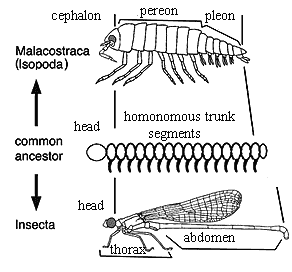
pereon crustacean anatomy. Generally, the thorax; the anterior portion of the trunk, posterior to the maxilliped-bearing segments. If part of the thorax is fused to the head (a cephalothorax), the term refers to the unfused portion. The pereon typically includes 6-7 segments (pereonites or thoracomeres) and bears uniramous appendages which are used for locomotion. The region posterior to the pereon is the pleon abdomen). Image adapted from Abzhanov & Kaufman (2000).
phenotype the observable characteristics corresponding to a particular DNA complement, or genotype. For example, humans whose genotype includes an extra copy of chromosome 21 show the phenotype known as Down's Syndrome.
phylogenetic used to describe a system, tool, technique or grouping which attempts to follow or demonstrate the actual evolutionary sequence of events.
photic zone in ecology, that part of the water column and sea bottom within which sunlight penetrates in sufficient amounts to permit photosynthesis.
phototaxis movement in response to light.
pinacocyte flat cells which form the pinacoderm. The pinacocytes may form a closely-packed layer, but may also be loosely arranged, with the intervening space occupied by collagen bundles. Bavestrello et al. (1998).
pinacoderm (sponge anatomy) sponge ectoderm analogue, containing incurrent pores.
pleon crustacean anatomy. The abdomen; the body region posterior to the pereon, typically with 3-5 segments. The term does not include the post-genital segments and telson, where these elements are present.
plesiomorphic "primitive." A plesiomorphic character is one retained, essentially unmodified, from the common ancestor of a group.
pleuro- in anatomy, a prefix or particle meant to suggest that a structure is associated with the side of the root structure.
plicate folded or, more accurately, pleated or wrinkled.
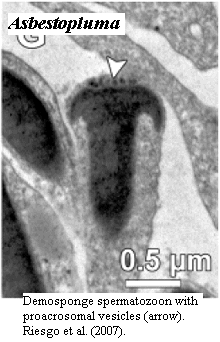
plugged junction protein (or at least non-membranous) partition between the syncytium and a cell in hexactinellid sponges. The plugged junction is probably permeable to ions and contains pores which seem to allow vessicles to pass through. See image, citations, and additional discussion at Hexactinellida.
-pod (Crustacea) a suffix applied to appendage elements, perhaps originally meant to suggest that the element was part of the main axis of a leg, but now essentially meaningless.
-podite (Crustacea) a suffix applied to appendage elements, perhaps originally meant to suggest that the element was a secondary outgrowth from the main axis of a leg, but now essentially meaningless.
podomere crustacean anatomy. Leg segment.
polyphyletic a term used to describe a taxon which does not include the last common ancestor of its members. This usually occurs when two separate groups converge on the same form by "convergent evolution" or homoplasy.
primorph cultured, "long-term aggregates of ... sponge tissue that were developed as a model system for understanding gene expression during the construction of the adult sponge body plan." Leys & Erevskosky (2006).
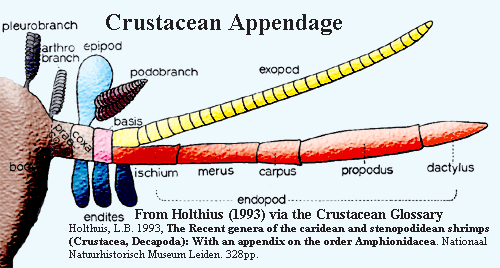
proacrosomal vesicle vesicles formed from the Golgi apparatus in developing spermatozoa. "The round Golgi apparatus of spermatocytes becomes hemispherical in Step 1 spermatids. At this step, the TGR [trans-Golgi reticulum, a region of the Golgi apparatus] shows a few dense-cored vesicles proacrosomal vesicles) and many coated vesicles of different sizes. Proacrosomal vesicles are considered the first intermediates in the formation of the acrosome." Martínez-Menarguez et al. (1996). Since the quoted paper deals with rat biology, don't assume that it necessarily applies to all invertebrates.
proboscipedia a gene, abbreviated for pb, the hox2 homologue of arthropods. See Hox Genes.
prospyle (sponge anatomy), "the entry hole/channel/pore leading into the area of choanocytes. It is formed by one donut-shaped cell, the porocyte." Midterm Review.
protocerebrum (arthropod anatomy) the neural apparatus of the acron, generally the largest part of the brain, associated with vision and chemosensation. See image at central body.
protopod The proximal part of the crustacean appendage, consisting of the proximal coxa and more distal basis. See Dr. Joel Martin's Crustacea Glossary for details and exceptions.
receptor tyrosine kinase "Protein-tyrosine kinases (PTKs) play important roles in the response of cells to different extracellular stimuli. They are divided into two major groups, the receptor tyrosine kinases (RTKs), which are membrane-spanning molecules with similar overall structural topologies, and the non-receptor TKs, also composed of structurally similar molecules." Müller 2001). RTKs are important signal transduction molecules which mediate the effects of various develomental signals.
reticulum, reticular a network, net- or web-like, or (conceptually) complex and interconnected.
rhizoid generic anatomical term referring to any outgrowth that looks or acts like a root.
sclerocyte (sponge biology) a spicule-forming cell in sponges. Sclerocytes often work in pairs.

septate junction (ultrastructure) "An intercellular junction found in invertebrate epithelia that is characterized by a ladder like appearance in electron micrographs. Thought to provide structural strength and to provide a barrier to diffusion of solutes through the intercellular space. Occur widely in transporting epithelia and are controversially considered analogous [now probably homologous -- ATW] to tight junctions (zonula occludens)." Biology Online. "The best-characterized function of invertebrate pleated septate junctions, hereafter referred to simply as septate junctions, is to form a barrier that prevents free diffusion of water and solutes between adjacent epithelial cells ... [S]eptate junctions ... have regularly spaced septa bridging an ~15-nm intercellular space." Wu et al. (2004).
septum (1) in anatomy, any wall-like structure which divides a space or (2) a flexible partition which controls movement between two anatomical spaces. (3) In archaeocyath anatomy, one of the vertical walls which partions the intervallum.
sessile opposite of motile. A mode of life in which the organism is fixed to a substrate and does not move.

sex combs reduced a gene, abbreviated for scr, a hox5 homologue of arthropods. See Hox Genes.
silicase (sponge biochemistry), enzyme in sponges, proposed to be involved in silica restructuring and maintenance. The proposed mechanism involves bound zinc acting as a Lewis acid catalyst to break the silicate ester bond between silicon and oxygen.
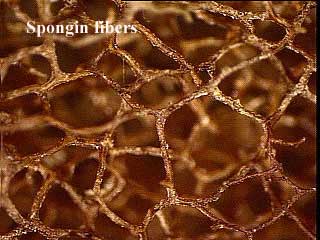
silicatein sponge biochemistry), enzyme which catalyzes the formation of silicate polymers. Click on thumbnail for details of mechanism from Cha et al. (1999).
siliceous composed of, or containing, silicates.
somite in crustacean anatomy, a body segment. This word carries no baggage relating to a specific developmental program or germ layer, as it does in vertebrate anatomy. It tends to be used in discussions of development, but is not limited to embryology.
spicule a mineralized skeletal element.
spongin sponge biology) a collagen-related protein which is found as an important structural element in demosponges. Unlike most collagens, it is a glycoprotein and apparently also contains halogen-substituted tyrosine (bromine or iodine).
spongocoel (sponge anatomy) "the large cavity of tubular sponges through which water passes before being expelled through the osculum." Glossary.
stem in phylogenetics, (a) a stem group is a clade defined in the form "all organisms who are more closely related to their last common ancestor with X than to their last common ancestor with Y." This is usually abbreviated X > Y. (b) more loosely , a "stem X" is any organism more closely related to clade X than to any other clade of equivalent size or importance.
symplesiomorphy a shared primitive character. This awkward word is actually one of Willi Hennig's most profound contributions. He pointed out that you cannot infer anything about phylogeny from the fact that two organisms share characters inherited from a common ancestor, other than that common ancestry. Example: we suppose that Rudolph the Red-Nosed Reindeer is the founder of a clade (Erythronaria) with living members A, B, C, and D. A and B have red noses. C and D have green and blue noses, respectively. What phylogenetic facts can we infer? None! Both C and D are derived, relative to Rudolph, but their noses are apomorphic (derived, but not shared). A and B have a shared character, but it is a symplesiomorphy (shared, but not derived). Since none of the reindeer have a shared, derived character (synapomorphy) relative to Rudolph, we can draw no phylogenetic inferences and know nothing about the branching order of their descent from Rudolph. See further discussion at synapomorphy. See also Dendrograms: Introduction.
synapomorphy (cladistics) See background of example at symplesiomorphy. A derived character which is shared by members of a group and distinguishes them from other organisms descended from the same common ancestor. Using the same example as at symplesiomorphy, suppose that A and B have rednoses, as before, but C and D both have blue noses. Since blue nose is a synapomorphy (both shared and derived, with respect to the original red nose) we may correctly infer that C and D are more closely related to each other than either one is to Rudolph, A, or B. That is, C and D form a clade. Only synapomorphies may be used to infer phylogeny. We still know nothing about the relative positions of A and B. (Note also that a synapomorphy may be secondarily lost in later descendants, but still "counts" for phylogenetic inference). See also Dendrograms: Introduction.
syncytium (cell biology) a tissue composed of cells without individual plasma membranes. In essence, the entire tissue/organ is a single cell with multiple nuclei. Muscle fibers are usually syncytial.

tabulate having (flat) horizontal partitions, or resembling such a partition. The partitions may be referred to as tabulae.
tagma arthropod anatomy. Plural = tagmata. Major body division, made up of several segments with similar specializations, e.g. thorax, abdomen.
tapetum lucidum the reflective layer of the retina that causes the eyes of, e.g., cats to appear to shine in darkness. An adaptation for vision at low light intensity.
tetractine (sponge anatomy) a spicule with four rays. See Spicule Terms.
tetraxon sponge anatomy) a spicule with four axes. Maggenti et al. (2005) define the term to include only "spicule[s] of 4 equal and similar rays meeting at equal angles" (emphasis aded). As far as we know, no sponge has such a spicule. Same as teraxonid. According to some sources, same as quadriradiate. We suspect this is wrong. Tetraxons may have either four or eight radii. See the exmple on the far right of the "Tetraxon" row in the figure. Linguistically, "tetractine" also refers to four points and so is also potentially misleading. See Spicule Terms.
thrombolite a form of microbialite or bacterial "reef." "Stromatolites are microbial structures (microbialites) with internal laminations; thrombolites are microbial masses with clotted internal textures. ... Thrombolites range from the Neoproterozoic to the Recent. They were common in the Cambrian and Ordovician and the Devonian, but rarer though present in every other Phanerozoic system. Thrombolites have a much more varied environmental distribution than stromatolites, being found in cryptic spaces such as cavity walls as well as on exposed surfaces." Taylor & Wilson (2003). See several images at Irregulares.
tinman a homeodomain transcription regulator associated with heart development in divers bilaterians. See Hox Genes.
triactine (sponge anatomy) a spicule with three rays. See Spicule Terms.
triaxon (sponge anatomy) a spicule with three axes. See Spicule Terms.
tritocerebrum (arthropod anatomy) the third and most posterior section of the brain, associated with the antennae in crustaceans.
toolkit genes see Hox Genes. Genes coding for transcriptional regulators which are often adapted for use in different ways during the development of different organisms, or even in the same organism, during different stages of development.
transcription the process by which RNA is synthesized from a DNA template.
trophic in ecology, relating to feeding -- not the mechanics of eating, but the issues relating to who eats whom in the ecosystem, food resource allocation and partitioning within a species or guild, etc.
ultrabithorax a gene, abbreviated for ubx, a middle class hox gene of arthropods. See Hox Genes.
vesicle in archaeocyath anatomy, same as dissepiment.
Williston's Law "Williston (1914, p. 21) stated that, 'a law in evolution [is] that the parts in an organism tend toward reduction in number, with the fewer parts greatly specialized in function.' This principle has been inferred to be prevalent feature of invertebrate evolution, for example, within arthropod limbs and body segments ... ." Sidor (2001: 1433).
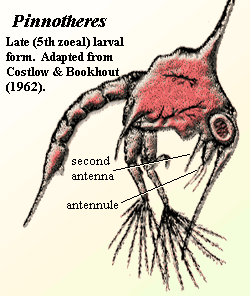
zoea In crustacean development, the name sometimes applied to intermediate larval stages (after the nauplius). The zoea is a free-living larva with functional thoracic appendages, but appendages on the pleon (if any) are absent or rudimentary.
Page by: ATW070701
Last Revised: ATW070825
checked ATW070725